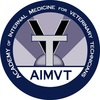A NOTE FOR INTERNATIONAL CANDIDATES:
AIMVT is a US-based organization and the AIMVT certifying exam was originally developed for candidates from the United States. Therefore, expect to see information on the exam that may be specific to the US. Every effort has been made to make the exam as location-independent as possible, however some differences may exist.
AIMVT is a US-based organization and the AIMVT certifying exam was originally developed for candidates from the United States. Therefore, expect to see information on the exam that may be specific to the US. Every effort has been made to make the exam as location-independent as possible, however some differences may exist.
Sample Questions
Domain – DIAGNOSTIC & LABORATORY TESTS and STUDIES
1. Mechanical distortion of the muscle membrane by a needle electrode causes the membrane to depolarize. This produces a brief burst of electrical activity. The study of this is called a(n)
A. Electroencephalography (EEG)
B. Electromyography (EMG)
C. Motor Nerve Conduction Velocity (MNCV)
D. Somatosensory Evoked Response (SEPs)
Domain – DISEASES
2. An 8 year old tabby presents acutely non-ambulatory, hypothermic, obviously painful and has no femoral pulses. The top differential for this cat would be?
A. Ascending myelomalacia
B. FCE
C. Iliac thrombosis (Saddle thrombosis)
D. IVDD
3. In cats, which is the causative agent of a protozoal meningoencephalitis in which care needs to be exhibited in the handling of fecal matter?
A. Cuterebra
B. Ehrlichia canis
C. Toxacaris
D. Toxoplasma
Domain – Animal Care
4. You are recovering a patient with known intracranial disease and ICP from a lumbar collection of CSF. The patient seemed to be recovering normally but then became non-responsive and you notice the patient has an absent PLR and ipsilateral mydriasis. The most likely cause of this is:
A. Brain herniation
B. Decreased ICP
C. Hypertension
D. Hypotension
1. Answer: B 2. Answer: C 3. Answer: D 4. Answer: A
1. Mechanical distortion of the muscle membrane by a needle electrode causes the membrane to depolarize. This produces a brief burst of electrical activity. The study of this is called a(n)
A. Electroencephalography (EEG)
B. Electromyography (EMG)
C. Motor Nerve Conduction Velocity (MNCV)
D. Somatosensory Evoked Response (SEPs)
Domain – DISEASES
2. An 8 year old tabby presents acutely non-ambulatory, hypothermic, obviously painful and has no femoral pulses. The top differential for this cat would be?
A. Ascending myelomalacia
B. FCE
C. Iliac thrombosis (Saddle thrombosis)
D. IVDD
3. In cats, which is the causative agent of a protozoal meningoencephalitis in which care needs to be exhibited in the handling of fecal matter?
A. Cuterebra
B. Ehrlichia canis
C. Toxacaris
D. Toxoplasma
Domain – Animal Care
4. You are recovering a patient with known intracranial disease and ICP from a lumbar collection of CSF. The patient seemed to be recovering normally but then became non-responsive and you notice the patient has an absent PLR and ipsilateral mydriasis. The most likely cause of this is:
A. Brain herniation
B. Decreased ICP
C. Hypertension
D. Hypotension
1. Answer: B 2. Answer: C 3. Answer: D 4. Answer: A
Reading List
Knowledge List
Click here to view/download Neurology Knowledge List.
Exam Domains/Exam Content
Click here to view/download the Neuro Exam Domain/Exam Content List.
